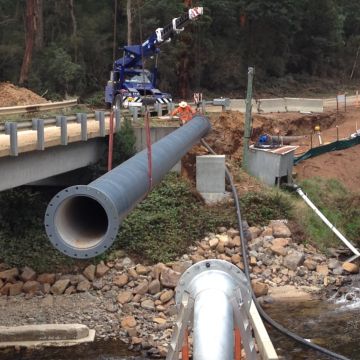Launceston flood levee
19/07/2021

The City of Launceston was established on a floodplain in 1806 and has since experienced 36 significant floods causing harm to life and property.
A levee system was established in the late 1950s to protect the city and low-lying suburbs but the system subsided and degraded over time. Federal funding was allocated to an upgrade and in 2013 we began work to upgrade a 732-metre section of the levee system in the Inveresk precinct.
The Launceston flood levee project involved demolition of the existing concrete levees, timber walkways and rotundas and the construction of a new reinforced concrete levee system.
During the demolition of the existing concrete levee, 2000 tonnes of material were removed. The new structure features:
- 77 precast panels, insitu footings and buttresses comprising 5000 tonnes of reinforced concrete
- 238 structural piles totalling more than 4000 lineal meters of 310UC steel piles
- 1040 vinyl sheet piles making a total of over 6000 lineal metres
Inveresk is an important precinct, and is home to historical, cultural, educational and sporting facilities. There’s significant pedestrian movement through the precinct, and access to facilities, homes and businesses had to be maintained throughout the construction period. Public safety was a priority, as well as protection for heritage buildings near the worksite.
The flood history of the area was incorporated into the design of the levee wall, with embedded details cast into the concrete panels representing the river system and dates of significance.
Careful project planning and execution was essential to overcome challenges including latent ground conditions, location of critical services and underground infrastructure, and the potential for inundation.
Tight project time constraints meant high-risk activities needed to be undertaken concurrently, including working at heights, foundation stabilisation (piling), deep excavation, foundation piling and complex crane lifts.
The project was completed on time, on budget and with no lost-time injuries, delivering an essential piece of infrastructure to protect the community and reduce the impacts of a 1-in-200 year flood.
As civilisation and industry in the area grew, a suburb was established on the Tamar River floodplains. It was protected only by low earth levees – the suburbs should probably never have been built there – but now we face the issue that a major inner city suburb with a substantial amount of Launceston’s industry needs protection from a levee system. It’s a major infrastructure project, which brings huge benefits to the community.”
Launceston Flood Authority general manager Andrew Fullard
